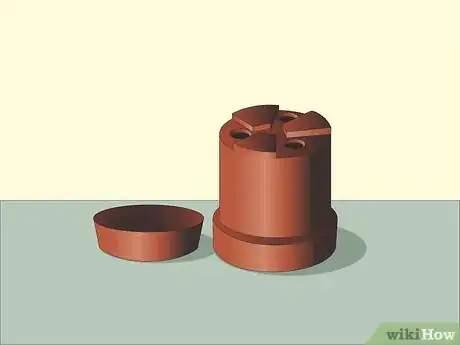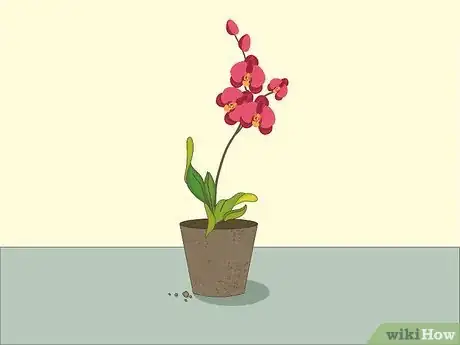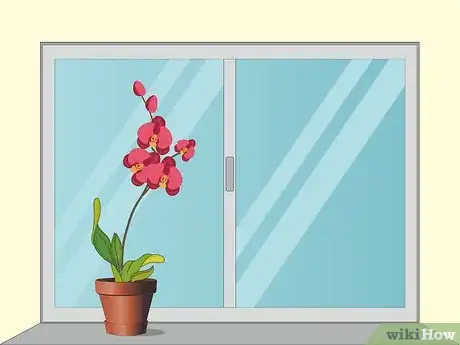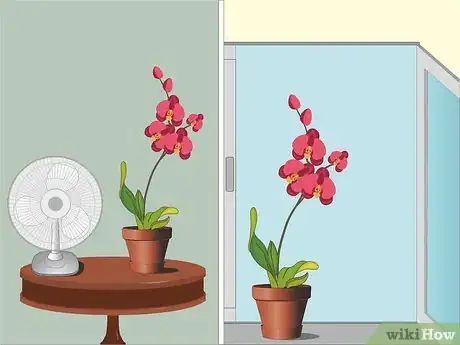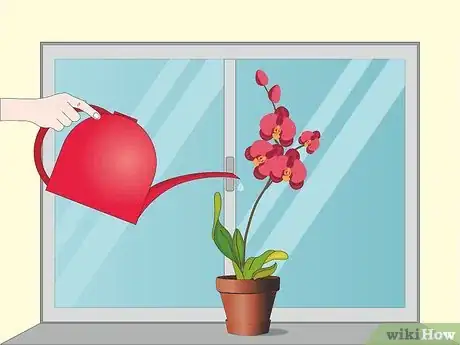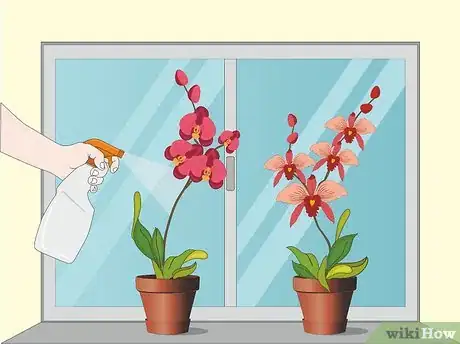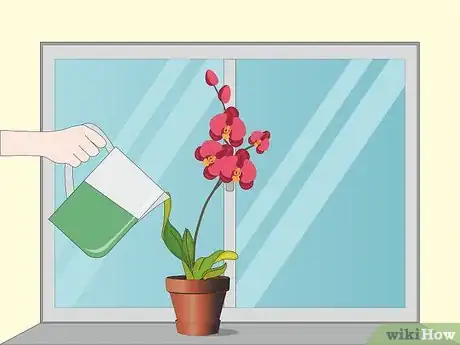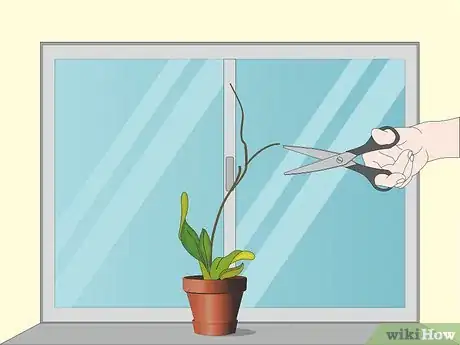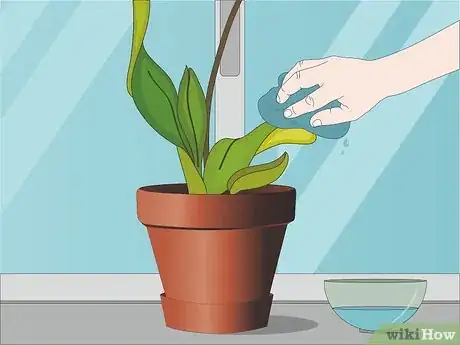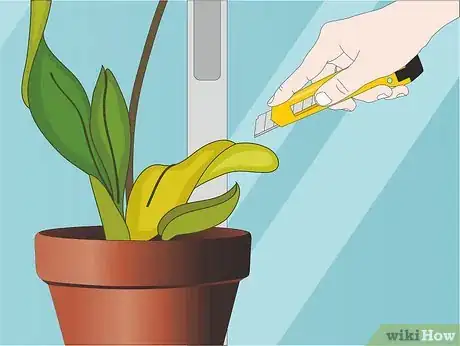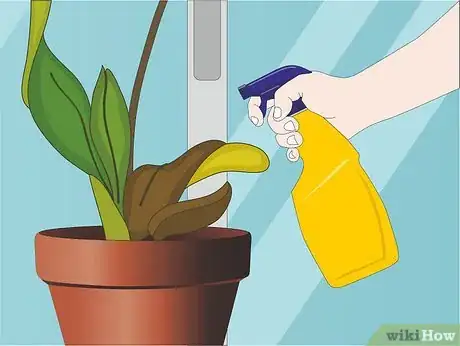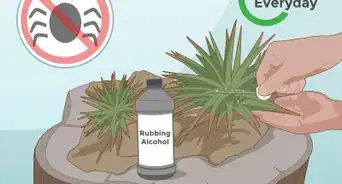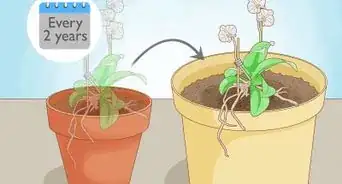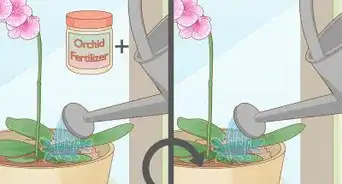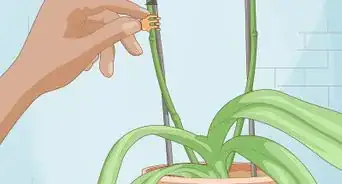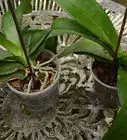This article was co-authored by Matt Bowman and by wikiHow staff writer, Sophia Latorre. Matt Bowman is a Gardener and the Owner of the Tradition Company, based in Atlanta, Georgia. Since 2006, Tradition Company provides car washing, lawn care, property maintenance, pressure washing, maid services, firewood delivery, and Christmas trees. With over 20 years of gardening experience, Matt specializes in organic vegetable gardening and general gardening practices. He holds a BA in Journalism from the University of Georgia.
There are 10 references cited in this article, which can be found at the bottom of the page.
wikiHow marks an article as reader-approved once it receives enough positive feedback. This article received 92 testimonials and 90% of readers who voted found it helpful, earning it our reader-approved status.
This article has been viewed 4,596,071 times.
Orchids are beautiful, delicate flowers that come in array of colors, shapes, and sizes. There are over 22,000 species of orchids, and care requirements may vary based on the type. However, you can follow some simple guidelines, regardless of what kind of orchid you have, to keep it healthy and looking great.
Things You Should Know
- Monitor the orchid to determine the best time to repot and then gather potting materials and a slightly larger pot.
- Measure out the potting material you need and cover the mix in hot water. Strain the mix and remove the orchid from its old pot, away clearing dead roots.
- Place the orchid in the new pot and press the damp potting mix into the pot next, ensuring the orchid stands upright when you’re finished repotting.
Steps
Creating the Right Environment
-
1Use pots with drainage holes. It’s imperative that the orchid pots are equipped with drainage holes to allow excess water to run out of the pot. Otherwise, root rot may kill your beautiful plants! If your orchids are in pots without drainage holes, repot them into new ones.[1]
- Put a saucer or drip tray underneath the pots to prevent excess water from spilling on your floor.
-
2Provide a fast-draining potting medium designed for orchids. You can choose between a bark-based or moss-based potting medium. A bark-based medium drains well and will help prevent overwatering, but can break down quickly. A moss-based medium retains moisture better but it necessitates careful watering and may need to be repotted more often.[2]
- If your orchids aren’t in the right kind of potting medium, repot them to help them thrive.
Advertisement -
3Place the pots near south- or east-facing windows, if possible. Orchids need strong, but indirect, light to thrive. If you can, place them near south- or east-facing windows to ensure they receive the right amount and intensity of sunlight. If you only have a west-facing window, cover it with a sheer curtain to keep the orchids from getting burned.[3]
- Placing the pots near a north-facing window may not provide them with enough light to bloom.
-
4Maintain a temperature of 60–75 °F (16–24 °C) in your home. Orchids thrive in moderate temperatures, and will die if they get too cold. Though the correct temperature varies based on the species of orchid, in general you should aim to keep your home above 60 °F (16 °C) at night. During the day, the temperature should be 10-15 degrees warmer than that.[4]
-
5Provide gentle air circulation. Because orchids aren’t grown in soil, you must provide air circulation to keep the roots healthy. In mild months, you can open windows in your home to provide a gentle breeze. Otherwise, use an overhead fan on a low setting or an oscillating fan directed away from the orchids to keep the air from getting stale or stagnant.[5]
Watering, Feeding, and Pruning Orchids
-
1Water the orchids just before they go dry. It’s important to water an orchid based on how much water it uses, rather than after a certain number of days. Every few days, gently stick 1 or 2 fingers into the potting medium, then pull them out and rub them together. If you don’t feel any moisture on your fingers, lightly water the orchids by pouring water over the potting medium and allowing it to soak in. After a few minutes, dump out the excess water in the saucer or drip trays below the pots.[6]
- Depending on the climate, humidity levels, and potting medium, you may need to water the orchids several times per week to once every several weeks.
- Clear pots can help you determine when it’s time to water your orchids—if there’s no condensation on the inside of the pots, it’s time to water.
-
2Mist orchids daily if the humidity level in your home is below 40%. Orchids do best in environments with 40-60% humidity. Pick up a hygrometer from a gardening center or superstore and use it to test the humidity in your home. If the humidity is less than 40%, use a spray bottle with a fine mist setting to lightly mist the orchids and their potting medium once per day.[7]
- If the humidity in your home is higher than 60%, place a dehumidifier in the room where your orchids are to prevent the growth of bacteria and fungi.
-
3Fertilize the orchids once per month while they’re flowering. Use a balanced liquid fertilizer, such as 10-10-10 or 20-20-20. Mix it at half-strength and use it to feed the orchids once per month while they’re flowering. Do not water them within several days after fertilizing them, or the nutrients will simply leach out with the water.
- After flowering, the foliage growth will eventually stop. You can give the plant less water and fertilizer until new leaves start to grow again.
-
4Cut off spent stems when the flowers have died. Orchids do not flower more than once on the same stem, with the exception of the Phalaenopsis, or moth orchid. If you have a Phalaenopsis, cut the stem just above the bottom 2 nodes, or joints of the stem once the flower has died.[8] For orchid varieties with pseudobulbs, cut the stem just above the pseudobulb.[9] For other orchid varieties, cut the entire stem off as close to the potting media as possible.[10]
- The pseudobulb is a thickened stem at the base of each growth.
- Always use sterile tools to prune orchids.
Handling Pests and Diseases
-
1Remove scale insects and mealybugs by hand. Signs of scale insects and mealybugs include sticky leaves and black, sooty mold. Use your hands to remove all the visible insects on the top and underside of the leaves and flower stalks.[11]
-
2Clean the affected leaves with soapy water. After removing the insects by hand, add a squirt of dish soap to a cup or bowl and add room-temperature water. Dip a soft cloth in the solution, then gently wipe down each leaf and flower stalk. The soapy water will remove the stickiness and soot as well as kill any remaining insects.[12]Advertisement
-
3Spray the orchids with an insecticide if problems persist. If you removed the bugs and cleaned the leaves but are still seeing signs of an infestation, pick up an insecticide at your local garden center. Ask an employee to help you find an insecticide that is safe to use on orchids. Follow the application instructions on the package.[13]
-
4Cut away any diseased tissue. If you notice that your orchid has discolored leaves or spots on it (like cream, yellow, brown, or black), it is likely suffering from a disease. The first step is to remove as much of the infected tissue as possible. Use a sterile cutting tool to cut away diseased leaves, stems, and flowers. Be sure to disinfect your gardening tools before and after removing infected tissue.[14]
- In some cases, it may be best to dispose of the entire plant to keep the disease from spreading.
-
5Treat infections with fungicide or bactericide. Common bacterial infections that may affect orchids include brown rot, black rot, and brown spot, indicated by dark spots on the leaves or pseudobulbs. Common fungal infections include blight and root rot, indicated by rotting roots, pseudobulbs, and leaves. After cutting away the infected tissue, spray the orchid with a fungicide or bactericide, depending on what it is suffering from.[15]
- You can find these products at your local gardening center.
Community Q&A
Did you know you can get expert answers for this article?
Unlock expert answers by supporting wikiHow
-
QuestionHow often should you water an orchid?
 Matt BowmanMatt Bowman is a Gardener and the Owner of the Tradition Company, based in Atlanta, Georgia. Since 2006, Tradition Company provides car washing, lawn care, property maintenance, pressure washing, maid services, firewood delivery, and Christmas trees. With over 20 years of gardening experience, Matt specializes in organic vegetable gardening and general gardening practices. He holds a BA in Journalism from the University of Georgia.
Matt BowmanMatt Bowman is a Gardener and the Owner of the Tradition Company, based in Atlanta, Georgia. Since 2006, Tradition Company provides car washing, lawn care, property maintenance, pressure washing, maid services, firewood delivery, and Christmas trees. With over 20 years of gardening experience, Matt specializes in organic vegetable gardening and general gardening practices. He holds a BA in Journalism from the University of Georgia.
Gardener & Owner, Tradition Market & Garden
-
QuestionAfter flowering, should I cut off any brown or dead looking stalks?
 Lauren KurtzLauren Kurtz is a Naturalist and Horticultural Specialist. Lauren has worked for Aurora, Colorado managing the Water-Wise Garden at Aurora Municipal Center for the Water Conservation Department. She earned a BA in Environmental and Sustainability Studies from Western Michigan University in 2014.
Lauren KurtzLauren Kurtz is a Naturalist and Horticultural Specialist. Lauren has worked for Aurora, Colorado managing the Water-Wise Garden at Aurora Municipal Center for the Water Conservation Department. She earned a BA in Environmental and Sustainability Studies from Western Michigan University in 2014.
Professional Gardener
-
QuestionNew leaves are growing at the end of two separate flower spikes and air roots. Should I just leave them on the parent plant?
 Lauren KurtzLauren Kurtz is a Naturalist and Horticultural Specialist. Lauren has worked for Aurora, Colorado managing the Water-Wise Garden at Aurora Municipal Center for the Water Conservation Department. She earned a BA in Environmental and Sustainability Studies from Western Michigan University in 2014.
Lauren KurtzLauren Kurtz is a Naturalist and Horticultural Specialist. Lauren has worked for Aurora, Colorado managing the Water-Wise Garden at Aurora Municipal Center for the Water Conservation Department. She earned a BA in Environmental and Sustainability Studies from Western Michigan University in 2014.
Professional Gardener
References
- ↑ http://www.bhg.com/gardening/houseplants/care/how-to-care-for-orchids/
- ↑ http://www.aos.org/orchids/orchid-care/what-is-the-best-potting-media.aspx
- ↑ http://www.aos.org/orchids/orchid-care/where-in-the-house-can-i-grow-my-orchid.aspx
- ↑ http://www.aos.org/orchids/orchid-care/orchids-101.aspx
- ↑ http://www.aos.org/orchids/orchid-care/orchids-101.aspx
- ↑ http://www.bhg.com/gardening/houseplants/care/how-to-care-for-orchids/
- ↑ http://www.bhg.com/gardening/houseplants/care/how-to-care-for-orchids/
- ↑ http://www.aos.org/orchids/orchid-care/where-do-i-cut-the-spike.aspx
- ↑ http://www.theorchidcolumn.com/2012/09/where-do-i-cut-my-cattleya-after-it.html
- ↑ http://www.orchidsmadeeasy.com/orchid-care-instructions/
- ↑ http://www.gardenersworld.com/plants/plant-inspiration/how-to-care-for-orchids2/
- ↑ http://www.gardenersworld.com/plants/plant-inspiration/how-to-care-for-orchids2/
- ↑ http://www.gardenersworld.com/plants/plant-inspiration/how-to-care-for-orchids2/
- ↑ http://staugorchidsociety.org/culturepests-diseases.htm
- ↑ http://staugorchidsociety.org/culturepests-diseases.htm
- ↑ http://www.aos.org/orchids/orchid-care/why-are-my-orchid-s-leaves-wrinkled-and-leathery.aspx
About This Article
The best way to take care of your orchid is to place it near a south- or east-facing window that receives strong, indirect light. Water your orchid whenever the soil feels dry, and fertilize it with a 10-10-10 fertilizer once a month while it’s flowering. Make sure the room your orchids are in receives circulation, or set an overhead fan to low if it doesn’t. For help from our Horticulturist reviewer on clearing bugs or removing diseased spots, read on!
